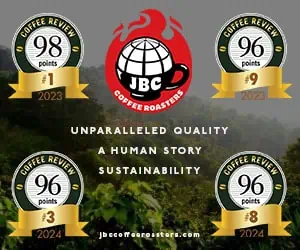I was talking to Scott Callaghan the Australian barista champion just before he left for London for the World Barista Championship and I mentioned to him about “densation.” It’s a clumsy word but its similar to the principle that occurs with the sorting of green beans in a good dry-mill where you have a ‘densimetric’ table that is on an angle and when it vibrates the larger beans go to the top and the smaller beans and the chipped and broken parts go to the bottom.
The same thing happens when you are making an espresso coffee when you bang a loaded porta-filter on a bench or as World Barista Champion Paul Bassett calls it: “settling” the coffee. By banging the porta-filter on a bench or a bar it sorts out the particle sizes of the ground coffee slightly so you get the bigger particles at the top and the smaller particles at the bottom to some extent. The finer the grind the less this will occur as the particles are a little more viscous due to the increased surface area and exposed oils. In other words the finer particles that are impregnated with oils tend to stick together a little more rather than separating.
Basically what it enables you to do is create a better extraction.
It is somewhat similar to how some espresso machines maintain a constant temperature at the brew-head by not having a repeated identical interval where the thermostat comes on. Rather it comes on in ever-diminishing intervals to stop the brew head from getting too much momentum and over-heating. A constant series of regular intervals going on without paus actually increases the temperature. By reducing the intervals to say 0.9 seconds, 0.8 seconds 0.7 seconds etc it will actually maintain a more constant temperature and stop the temperature from climbing.
As water passes through dry coffee particles in the porta-filter, if there is an apparent even sorting of particles from top to bottom, the water will become a ‘saturated solution’ very quickly. And once you have a saturated solution the water can’t actually absorb anything more. That’s the nature of a saturated solution in scientific terms. (By the way: a saturated solution is actually the main principle by which Swiss Water Process produce their decaffeinated coffee.)
So what happens as a result of the ‘densation’ effect is that coffee grounds are densimetrically sorted, and the water will flow more easily through the top part of the coffee puck. And when the water comes to the bottom of the coffee it will tend to extract the optimum flavour from there as well as taking some from the coarser particles at the top. So ironically you actually get a more ‘even’ extraction out of the coffee grinds than you would out of an even particle size distribution.
One of the other factors that it enables you to do is to grind the coffee a little coarser and that again enables you to sort the particle sizes out better again and that is all, of course, intertwined in a complex way with the brewing temperature which permits a higher temperature which will of course bring out a different flavor profile. Altogether it creates a slightly sweeter and cleaner style of espresso coffee.
I should add that I got this idea from Carl Staub of Agtron who demonstrated it for me using a Swift grinder where he served me three espresso shots and he actually adjusted the grinder while it was actually grinding. So he created the densation effect by adjusting the grinder itself.
He gave me three shots and the taste difference was phenomenal. It was like having three completely different coffees. The first one was great much cleaner and more complex; the second one was just OK, and the third one was not nice at all. # 1 was coarse at the top and finer at the bottom; # 2 was even from top to bottom, as you would normally have it, and # 3 was fine at the top and coarser at the bottom.
I was working on developing a grinder that could repeat this in a commercial way with a lovely guy by the name of Mike Del Zoppo who is now no longer with us. He has gone to that espresso machine in the sky, so we never ended up making a grinder that could repeat this time after time but it is certainly a potential new challenge for manufacturers.










